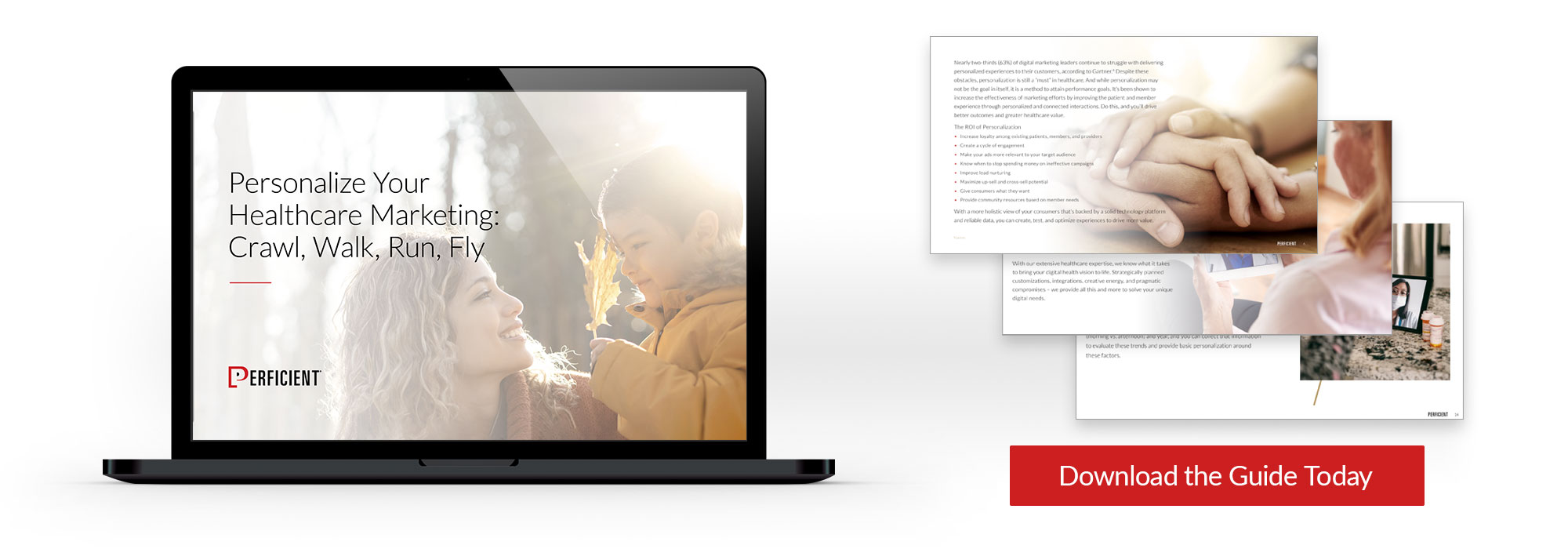The global pandemic solidified digital health’s vital role in meeting consumer needs. As a result, healthcare payers and providers continue to accelerate their digital capacity in order to meet consumer expectations and ensure business resilience.
Digital tools once considered a future-state have now become primary channels for vital care and meaningful customer interactions. Impacts extend beyond digital care delivery and are driving even greater executive attention to all aspects of digital. Today, digital includes data science goals of ingesting and acting on greatly increased volumes of patient-generated data, for example, to marketing approaches like personalization.
An All-Encompassing Digital Journey for Members and Patients
Improving digital engagement is imperative in industries like healthcare, where consumer acquisition has historically been a tedious process. To provide an all-encompassing digital journey for your members and patients, it’s important to look at everything, even those experiences that might be outside of your direct control – like telehealth or food insecurity – in order to give your consumers a fully connected experience. When your patients and members remain connected and engaged, they will bring more lifetime value to your organization through ongoing referrals and brand advocacy.
Three in four people say they want to have the same experience in healthcare that they receive from other businesses.
Enabling a tailored and relevant digital experience is a business imperative. COVID-19 implications resulted in fewer traditional touchpoints than before. Digital properties are both a proxy for those lost touchpoints and a means to differentiate your brand.
Whether a health plan or system, your brand must communicate in a personal way and provide relevant information across the entire journey. To accomplish this, many healthcare organizations are doubling down on data and turning to digital platforms with personalization capabilities to leverage that data and drive engagement.
A Shift on the Communications Spectrum
Marketing communications exist on a spectrum. At one end, you have mass marketing, where a blanket message is blasted out to give prospects the same experience. At the other end, you have one-to-one marketing, where a specific, tailored message is shared with a single target. This is true personalization. And what’s in the middle? Tactics that enable marketers to customize content, each with varying degrees of effort and investment.
Shaped by ecommerce experiences, consumers aren’t responding to the old “spray and pray” mass marketing approach; they have high expectations for a personalized – or at least a relevant – experience. Despite many companies understanding the importance of personalization and deeming it a high priority, most aren’t sure where to begin, or find implementation to be a slow, arduous process.
The healthcare industry has been slower to adopt personalization. If there’s ever a time to prioritize the digital experience, it’s now. According to Hubspot, 41% of healthcare consumers reported they would leave their healthcare provider altogether because of a lackluster digital experience, prior to the pandemic.
This struggle is amplified in healthcare, where it’s imperative that marketing messages are helpful without being invasive. It’s a delicate balance, as your users both want and expect you to provide relevant personalized experiences and recommendations based on their unique profile, condition(s), social environment, or expressed preferences, while not exposing or using information they consider confidential.
According to research by Gartner, 87% of surveyed marketing leaders said their organization is pursuing personalization, and nearly two-thirds (63%) continue to struggle with delivering personalized experiences to their customers.
Despite these obstacles, personalization is still a “must” in healthcare. And while personalization may not be the goal in itself, it is a method to attain performance goals. It’s been shown to increase the effectiveness of marketing efforts by improving the patient and member experience through personalized and connected interactions. Do this, and you’ll drive better outcomes and greater healthcare value.
The ROI of Personalization
- Increase loyalty among existing patients, members, and providers
- Create a cycle of engagement
- Make your ads more relevant to your target audience
- Know when to stop spending money on ineffective campaigns
- Improve lead nurturing
- Maximize up-sell and cross-sell potential
- Give consumers what they want
- Provide community resources based on member needs
With a more holistic view of your consumers that’s backed by a solid technology platform and reliable data, you can create, test, and optimize experiences to drive more value.
Learn more about personalization in healthcare
A powerful digital foundation gives you the ability to personalize experiences. While your organization may not yet deliver deeply personalized experiences, the potential is there. Partnering with a digital consultancy that specializes in healthcare solutions will help you reach that potential. Our experienced and award-winning team will not only help you implement the solution but also create a strategy to align the people and processes to embrace it.
Gain step-by-step guidance on how to overcome challenges, expand use cases, comply with regulations, combat bias in AI and ML models, successfully implement/execute/grow strategies, and use CDP/CRM/DXP to deliver personalized experiences through our interactive guide.
GET THE GUIDE: Personalize Your Healthcare Marketing: Crawl, Walk, Run, Fly


